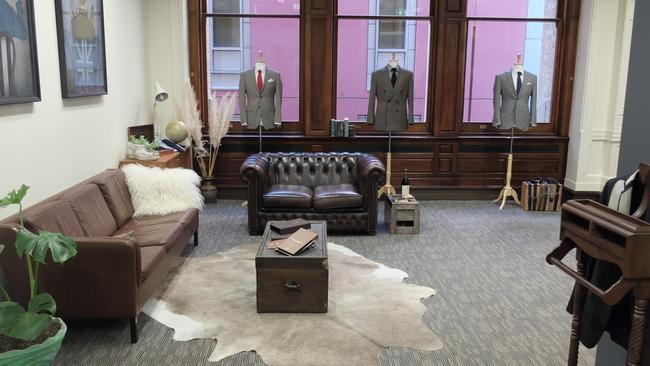How InStitchu spun $10m from cheap suits
BUYING a suit is expensive, time-consuming and generally a pain. Here’s how two uni mates turned it into a $10m powerhouse.
IS THE old adage “you get what you pay for” still true?
From financial services to consumer products, the concept is being turned on its head by nimble new competitors able to offer lower prices for the same products thanks to lean online business models.
Uni mates James Wakefield and Robin McGowan have turned that theory into a $10 million Aussie success story with InStitchu, an online menswear store where customers can design and order their own tailored suits and shirts.
The duo have struck deals with garment factories in Shanghai to source high-quality made-to-measure suits, which they sell for between $400 and $1000. They claim identical suits would cost anywhere up to $4000 from a traditional retailer.
“When we’re over visiting our suppliers, you see the suits getting made alongside ours with the same construction techniques, the same fabrics, but with ‘Made in Italy’ labels,” says Mr Wakefield.
The former Macquarie stockbroker says their model solves a number of pain points in the normal suit buying process. “When you go to David Jones or Myer to buy a suit, you’ve got to compromise on fit, style or price,” he says.
“Even when you buy the suit and think it’s good, you have to spend $200 getting it altered, so it’s really only at the end of that process that you decide whether or not you’re happy with your purchase.”
InStitchu offers free alterations (where most suit retailers make 50 per cent margin), and has a full refund policy. While refunds make up less than 1 per cent by dollar value — traditional online retailers can have anywhere up to a 25 to 30 per cent return rate — even if they make a loss on a sale, they see it as an investment in that customer.

“Our average customer is reordering every 122 days,” says Mr Wakefield. “It makes them far more confident to refer their friends, go back to work and tell their colleagues or even their boss.”
The 28-year-olds, who founded the business in 2012 after realising the how difficult it was to put together their professional wardrobes, have boosted its value to more than $10 million in three years.
Mr Wakefield and Mr McGowan, a former employee of eBay and commercial real estate firm CBRE, always wanted to start their own business. They were attracted to the model when they were both “dirt poor” because of one thing: cashflow.
“Our customers order the suit, then we’ll order it from the factory, whereas a traditional retailer has to go out and buy all the inventory,” Mr Wakefield says. “Because we’re not carrying those same overheads we don’t have to charge excessively to offset those risks.”
From day one, being cashflow positive meant the pair could pump all of the profits back into developing the website. Lower margins, though, mean this kind of business is a volume play.
“When we’re selling a few hundred suits a month that’s not a viable business; it’s only when we get scale that the business works,” Mr Wakefield says. “Generally you have to have a least 300 to 400 suits a month to get the decent factories to even look at you, which is one of the biggest barriers to entry.”
While they set out to make a purely online business, they soon realised some customers wanted to be able to come in for fittings.
Their first showroom was a $220-a-month rented room above the trendy Brewery cafe in Erskine St in Sydney’s CBD. Today they have a suite in the 350 George St building at the end of Martin Place, and a second showroom in Lonsdale St, Melbourne.

They’ve just signed the lease on a Brisbane showroom at the heritage-listed National Australia Bank building at 180 Queen St, and Mr Wakefield says the goal is to have eight showrooms within the next 12 months.
“We always focus on destination retail, conveniently located for corporate guys,” Mr Wakefield says. “Our store rollout has been pretty calculated. As soon as we get one cost centre profitable, we move onto the next one.”
After that, the pair have their sights set on a US expansion — already 15 per cent of InStitchu’s website traffic comes from the US.
The online made-to-measure suit niche is small but growing, with fellow Aussie start-up Joe Button also making a name for itself. Shoes of Prey, a custom shoe design website, follows a similar model.
They say any competition is good, because it just raises awareness. “Any competition is positive,” he says. “It’s going to get masses away from what they’re currently doing, and realising you can get a better offering at a better price.”
While partly due to the rise of internet shopping, the impact of the global financial crisis on the Chinese manufacturing industry was arguably what made these businesses possible. “Doing made-to-order stuff at scale is extremely difficult unless you’ve got the right production facility,” Mr Wakefield says.
“Post-GFC, lots of these Chinese manufacturing facilities were rocked by lower retail numbers, lower bulk orders coming through, so they naturally said, ‘How can we adapt our business model?’
“It takes a little bit of time for large-scale manufacturers to see that bulk orders aren’t the only way, that they can have these smaller production lines in made-to-order items where they make a higher margins.”
Doing business in China is about relationships, the pair have discovered. They were the first Western clients to visit the factory in eastern Chinese city of Jinhua, where they source the boxes they use to deliver their suits.
“Now they’ve got a big photo of us on their wall,” he says.




